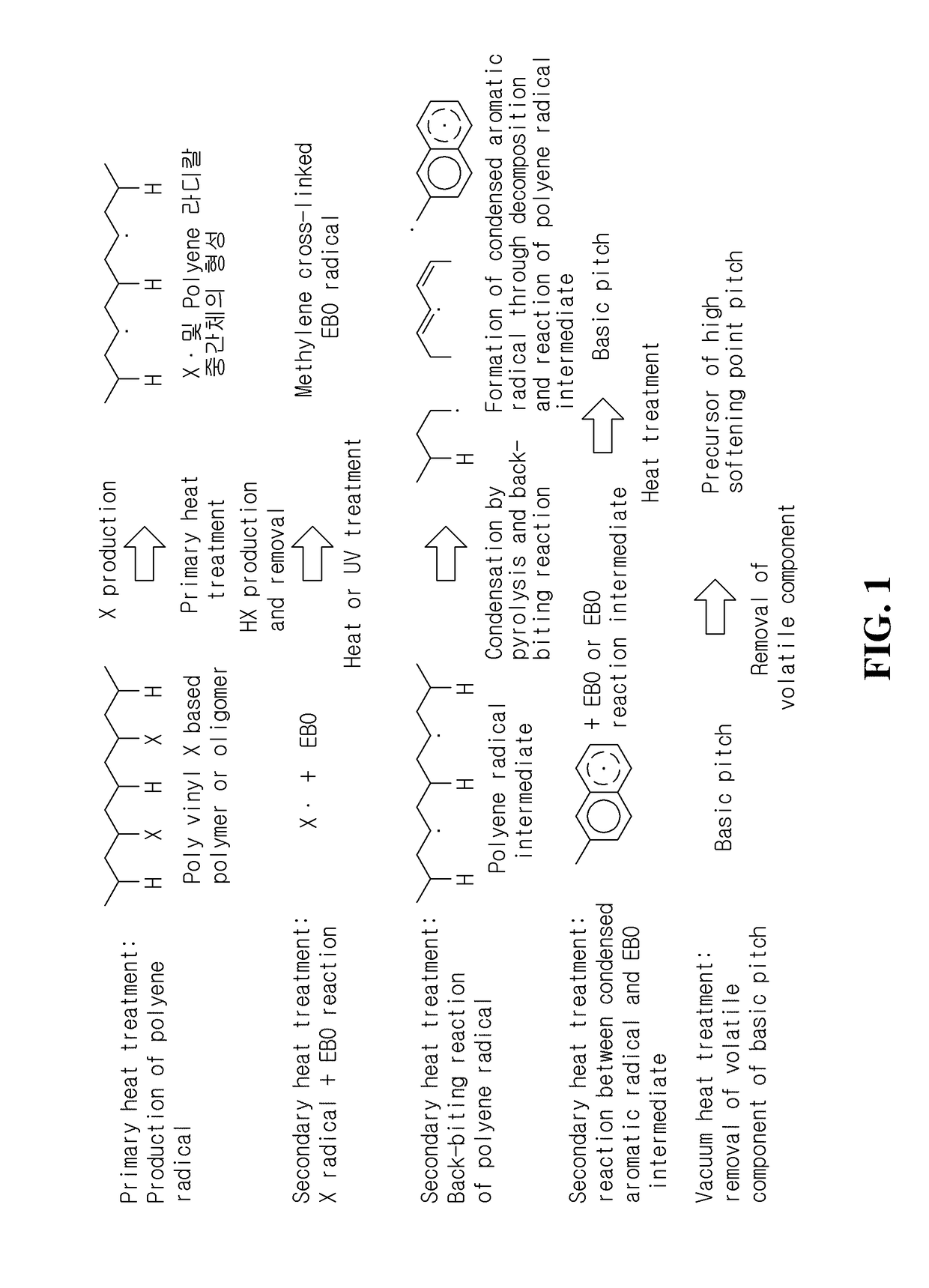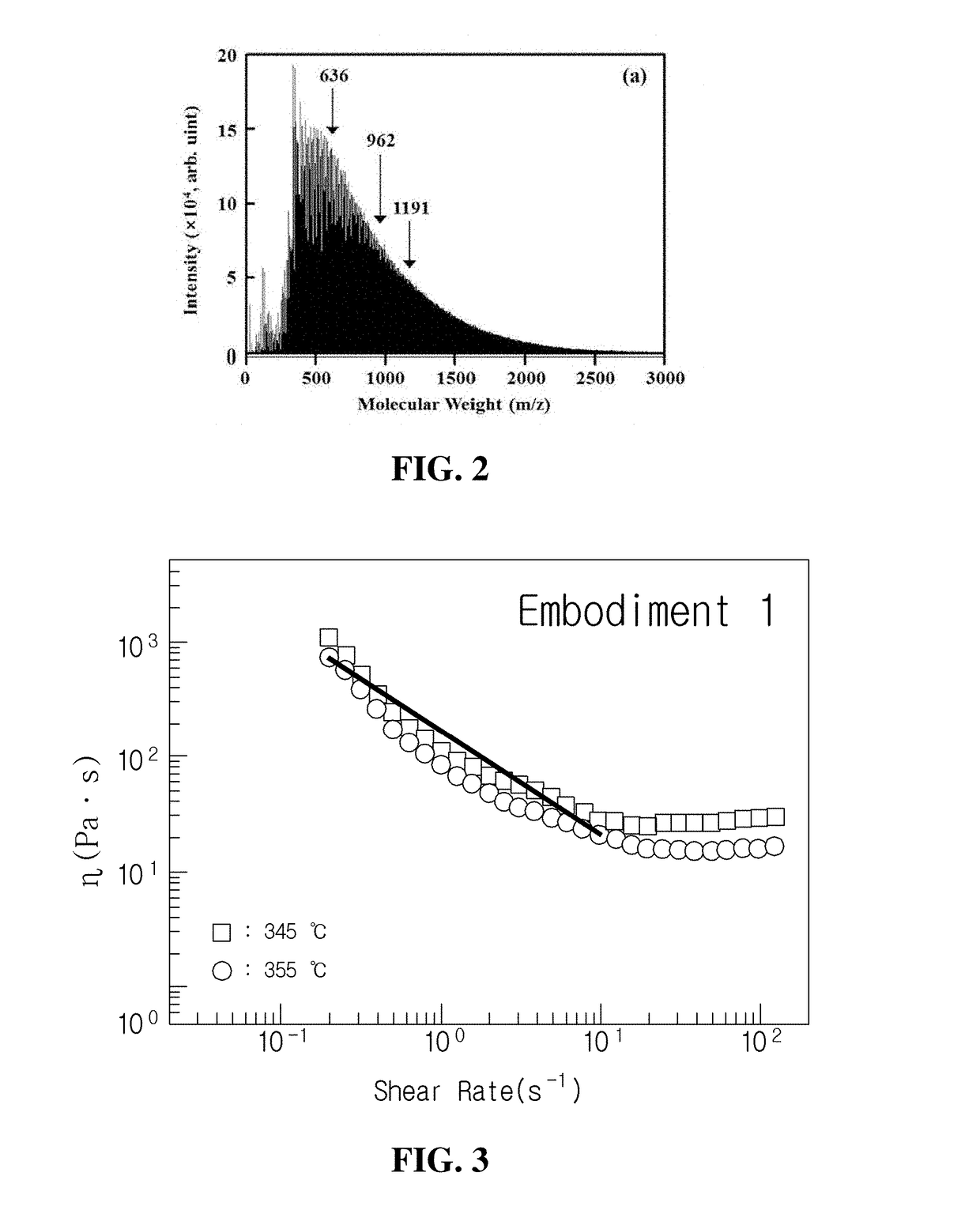Method of preparing high softening point pitch and high softening point pitch prepared thereby
a high softening point and high softening point technology, which is applied in the direction of working up pitch/asphalt/bitumen by thermal means, basic electric elements, cell components, etc., can solve the problems of low tensile strength of isotropic low molecular orientation, and limited application of mesophase pitch based carbon fiber to high elasticity and high thermal conductivity materials, etc., to achieve high yield index, increase the yield rate of high soft poin
- Summary
- Abstract
- Description
- Claims
- Application Information
AI Technical Summary
Benefits of technology
Problems solved by technology
Method used
Image
Examples
embodiment 1
[0074](1) Preparation of Pitch
[0075]In Embodiment 1, 80 g of ethylene bottom oil (EBO) and 20 g of polyvinyl chloride (PVC) powers were charged into a stirred glass reactor equipped with a reflux unit and mixed together while nitrogen was introduced, and heat treatment was performed at the temperature of 330° C. for three hours. After the heat treatment, non-reacting molecules or low-reacting molecules were removed by passing nitrogen gas at the flow rate of 100 mL / min for a predetermined time, heating was performed at the temperature of 370° C., heat treatment was performed for three hours, and then cooling was performed to a room temperature to prepare basic pitch and to obtain 72 g of basic pitch. Then, 50 g of prepared basic pitch were subject to vacuum heat treatment at the temperature of 350° C. under the pressure of 1 torr for 1.5 hours by a thin film evaporator to obtain 25 g of pitch
[0076](2) Evaluation of Physical Property of Source Material and Acquired Pitch
[0077]The sou...
embodiment 2
[0094]In Embodiment 2, 60 g of ethylene bottom oil (EBO) and 40 g of polyvinyl chloride (PVC) powers were charged into a stirred glass reactor equipped with a reflux unit and mixed together while nitrogen was introduced, and heat treatment was performed at the temperature of 330° C. for three hours. After the heat treatment, non-reacting molecules or low-reacting molecules were removed by passing nitrogen gas at the flow rate of 100 mL / min for a predetermined time, heating was performed at the temperature of 370° C., heat treatment was performed for three hours, and then cooling was slowly performed to a room temperature to prepare basic pitch and to obtain 70 g of basic pitch. Then, 50 g of the prepared basic pitch was subject to vacuum heat treatment at the temperature of 350° C. under the pressure of 1 torr for 1.5 hours by a thin film evaporator to obtain 23 g of pitch
[0095]The yield rate of the acquired pitch was 32 weight %, and the softening point measured was evaluated to 30...
embodiment 3
[0098]In Embodiment 3, 80 g of ethylene bottom oil (EBO) and 20 g of polyvinyl chloride (PVC) powers were charged into a stirred glass reactor equipped with a reflux unit and mixed together while nitrogen was introduced, and heat treatment was performed at the temperature of 320° C. for six hours.
[0099]After the heat treatment, non-reacting molecules or low-reacting molecules were removed by passing nitrogen gas at the flow rate of 100 mL / min for a predetermined time, heating was performed at the temperature of 380° C., heat treatment was performed for 1.5 hours, and then cooling was slowly performed to a room temperature to prepare basic pitch and to obtain 75 g of basic pitch. Then, 50 g of the prepared basic pitch was subject to vacuum heat treatment at the temperature of 360° C. under the pressure of 10 torr for two hours by a thin film evaporator to obtain 27 g of pitch
[0100]The yield rate of the acquired pitch was 41 weight %, and the softening point was 300° C.
[0101]The compo...
PUM
| Property | Measurement | Unit |
|---|---|---|
| Temperature | aaaaa | aaaaa |
| Temperature | aaaaa | aaaaa |
| Temperature | aaaaa | aaaaa |
Abstract
Description
Claims
Application Information
 Login to View More
Login to View More - R&D
- Intellectual Property
- Life Sciences
- Materials
- Tech Scout
- Unparalleled Data Quality
- Higher Quality Content
- 60% Fewer Hallucinations
Browse by: Latest US Patents, China's latest patents, Technical Efficacy Thesaurus, Application Domain, Technology Topic, Popular Technical Reports.
© 2025 PatSnap. All rights reserved.Legal|Privacy policy|Modern Slavery Act Transparency Statement|Sitemap|About US| Contact US: help@patsnap.com



